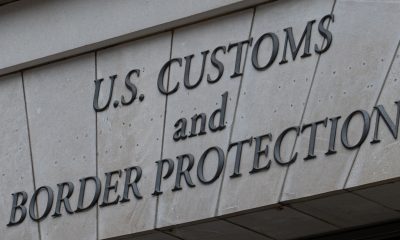National
Adding Cops and Arming Teachers Don’t Enhance Student Safety

By George E. Curry
NNPA Editor-in-Chief
WASHINGTON (NNPA) – Rather than deter violence, placing more police officers in schools has led to more students becoming entangled in the criminal justice system for such minor infractions as disorderly conduct, an in-depth study of the issue has concluded.
Despite that finding by the Justice Policy Institute, a nonprofit group that seeks ways to decrease incarceration, National Rifle Association (NRA) officials continue to argue that the best way to prevent tragedies such as the killing of 26 people in Newtown, Conn. is to arm teachers and place more police officers in schools.
In an appearance Sunday on NBC’s “Meet the Press,” Wayne LaPierre, executive vice president of the NRA said, “If it’s crazy to call for putting police and armed security in our schools to protect our children then call me crazy.” He added, “I think the American people think it’s crazy not to do it. It’s the one thing that would keep people safe.”
After LaPierre made that suggestion Friday at a news conference in which he would not take questions from reporters, Rep. Chris Murphy [D-Conn.] called it “the most revolting tone deaf statement I’ve ever seen.”
After the shooting rampage at Sandy Hook Elementary School in Connecticut, President Obama said he will push for gun legislation early next year. Many elected officials are supporting the move.
“I have found the statements by the NRA over the last couple of days to be really disheartening, because the statements seem not to reflect any understanding about the slaughter of children,” said Senator Joe Liberman [I-Conn.]. “But it’s obviously also true that the easy availability of guns, including military style assault weapons, is a contributing factor, and you can’t keep that off the table.”
The Justice Policy Institute published a report in November of last year titled, “Education Under Arrest: The Case Against Police in Schools.”
It stated, “Fueled by increasingly punitive approaches to student behavior such as ‘zero tolerance policies,’ the past 20 years have seen an expansion in the presence of law enforcement, including school resource officers (SROs), in schools. According to the U.S. Department of Justice, the number of school resource officers increased 38 percent between 1997 and 2007. Some cities, like New York City, employ more officers in schools than many small cities’ entire police force.”
The expansion of police has had an adverse impact on many students.
“With this rapid increase in the presence of law enforcement, including SROs, in schools, districts from around the country have found that youth are being referred to the justice system at increased rates and for minor offenses like disorderly conduct. This is causing lasting harm to youth, as arrests and referrals to the juvenile justice system disrupt the educational process and can lead to suspension, expulsion, or other alienation from school,” the report stated. “All of these negative effects set youth on a track to drop out of school and put them at greater risk of becoming involved in the justice system later on, all at tremendous costs for taxpayers as well as the youth themselves and their communities.”
The push to add more police at school began at the federal level with the concept of zero tolerance. The Gun Free Schools Act of 1994, signed into law by President Bill Clinton, required any jurisdiction receiving money through the Elementary and Secondary Education Act to adopt a policy that suspends a student for at least a year for bringing a firearm to school.
By the time 15 people were killed at Columbine High School in Littleton, Col. In 1999, President Clinton had already called for more police officers in the schools.
Clinton was reacting to some highly-publicized acts of violence rather than facts.
According to a 1996 study by the Centers for Disease Control, between 1992 and 1994, a youth had less than one in a million chance of suffering a violent death at school, including as a victim of homicide or committing suicide.
In addition, the National School Safety Center found that there was a 27.3 percent drop in the number of school-related homicides and suicides between 1992 (55) and 1998 (40) – the same period in which Clinton was calling for more police officers in schools.
Increased presence of police in schools has contributed to the school-to-prison pipeline, according to the Justice Policy Institute study.
“No data exists showing that SROs arrest youth of color more often than white students, but other data shows that youth of color are disproportionately arrested compared to white youth,” the report stated. “In school, youth of color are far more likely to be subjected to harsh punishments in school than whites. A study from the Applied Research Center shows that African American students are disciplined more often and more harshly than white students. Related to suspensions, a 1998 study from the Department of Education Office for Civil Rights shows that African American and Hispanic students are suspended from schools at disproportionate rates compared to white students.”
In South Carolina, for example, Black students make up 42 percent of the enrollment, but 75 percent of disorderly conduct charges, of which 90 percent are referred to law enforcement agencies. Blacks make up 19 percent of the students in Pinellas County, Fla. but 54 percent of the student arrests.
Communities should improve the learning environment rather than placing so much emphasis on adding police officers, according to some experts.
“Educating all youth and keeping them in school benefits communities in a variety of ways. Youth that are in schools are engaged during the day, preventing them from engaging in illegal behaviors. High school graduation increases social bonds and community ties which promote responsibility in young adults. In addition, keeping students in school saves communities millions in the long run.”
Some past supporters of NRA are now calling for a ban on assault weapons.
The Violence Policy Center produced a list of 33 mass shootings involving high-capacity ammunition magazines, including Sandy Hook Elementary School (Bushmaster assault rifle); Century Movie Theater in Aurora, Col. (Smith & Wesson M&P assault rifle); and Virginia Tech University (Glock 19 pistol).
The Violence Policy Center noted that the NRA’s corporate partners include many gun manufacturers, including the Freedom Group, the gun industry conglomerate of which Bushmaster, the manufacturer of the AR-15 assault rifle used in the Newtown, Conn. school mass shooting, is part of as well as Smith & Wesson, the manufacturer of another model of AR-15 assault rifle that was used in the Aurora, Colorado, movie theater mass shooting.
Supporters of tougher gun laws say they are not suggesting that school safety should be de-emphasized.
The Justice Policy Institute report concluded, “School safety should be a priority: it is not only important for protecting the physical safety of students, teachers, and staff, but also for maintaining a productive learning environment. However, law enforcement in schools is not the best nor most cost-effective way to achieve those goals. SROs and law enforcement in schools are not needed to keep kids safe, especially when youth pay the price of becoming involved in the juvenile justice system and suffer a lifetime of negative effects as a result.”
###








































